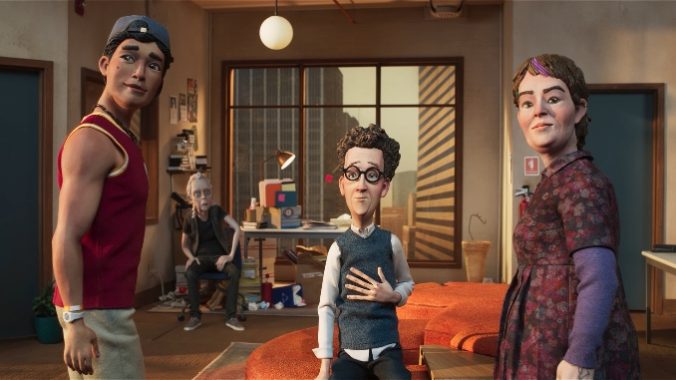In the Know Is a Hyperspecific and Thoroughly Funny Parody of Public Radio Egos
Image courtesy of Peacock
In our utterly perplexing television landscape, producers still haven’t discovered what exactly a “streaming hit” should look like, meaning they greenlight incredibly specific projects that we now know they are very willing to dump if it doesn’t set the internet on fire for weeks on end. The downside is that we only get invested in strange new shows with a degree of caution; the benefit is that we get stuff like In the Know.
Peacock’s new adult animated series, created by satire guru Mike Judge, The Office and Silicon Valley’s Zach Woods, and UCB alumnus Brandon Gardner, centers on a nebbish and self-absorbed public radio host, Lauren Caspian (Woods), who infuriates and undermines the meek team behind his mildly-popular talk radio show In the Know.
Clearly, radio host sitcoms are not “niche,” but a parody of the hypocrisies of neoliberal New York NPR personalities—in stop-motion animation form, no less—may be one of the most unique pitches that’s received a six-episode premiere season in recent years. In a much rarer move, In the Know is actually very good, skewering the contradictions of its self-important “nimrods” (the official term given in In the Know’s press notes) with sly, piercing style and eliciting more than a few full-bodied laughs from its niche but uncannily accurate satire.
When paired with his hypercritical leftist millennial researcher Fabian (Caitlin Reilly), the phased-out and suspected-squatter culture critic Sandy (Judge), or the frat boy intern Chase (Charlie Bushnell), it’s clear Lauren has some stiff competition for being the most erratic and belligerent in the small studio (he still wins by a country mile). Most of Lauren’s ignorant and unfeeling ire lands on his executive producer Barb (Succession’s J. Smith-Cameron) or his long-suffering sound engineer Carl (Carl Tart), whose straight-faced response to cringe-inducing chaos at In the Know hints they might make a very compatible pair in the future—hopefully Peacock is willing to commit to more of Judge/Woods/Gardner’s wit so we can see a relationship (read: something heartwarming and uncynical) blossom.
-

-

-

-

-

-

-

-

-

-

-

-

-

-

-

-

-

-

-

-

-

-

-

-

-

-

-

-

-

-

-

-

-

-

-

-

-

-

-

-








































